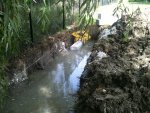Well I have started excavation for the wall that will retain the back side of my pool. While excavating we hit what I was concerned about, the water table. The elevation of the top of the retaining wall block was going to be the elevation of the bottom of the shallow end (see attached picture). As you can see after sitting all night the water table has risen up to within 5 inches of the top of the block or bottom of the shallow end. The deep end for this pool was going to be 2 feet deeper than the shallow end putting it about a foot and a half into the water table. I found a site that recommended putting pipe With holes in it below the deep end in stone and plumbing that to the pool pump.
I live in a cold winter climate which means the pool pump will be shut down for the fall and winter so no sump during that time. The next option I have come across is building a well point system with a submersible pump in a pipe buried in stone below the elevation of the bottom of the deep end. This is probably the lowest water table at this time of year and I am worried about the sump running at least three seasons of the year.
Next option is a relief valve in the main drain ( wasn't planning on using a main drain and even if I did there will be a lot of water entering the pool.)
SO this is where I am at now. Help Please!
My final option would be to raise the elevation of the pool and get it outta the water table. This would mean raising the height of the pool about 1 1/2 feet higher than the surrounding patio area. Wouldn't look to good though and would be very high to the surrounding back of the property.
How bad is it to have a sump system running all the time and what are my other options?
I live in a cold winter climate which means the pool pump will be shut down for the fall and winter so no sump during that time. The next option I have come across is building a well point system with a submersible pump in a pipe buried in stone below the elevation of the bottom of the deep end. This is probably the lowest water table at this time of year and I am worried about the sump running at least three seasons of the year.
Next option is a relief valve in the main drain ( wasn't planning on using a main drain and even if I did there will be a lot of water entering the pool.)
SO this is where I am at now. Help Please!
My final option would be to raise the elevation of the pool and get it outta the water table. This would mean raising the height of the pool about 1 1/2 feet higher than the surrounding patio area. Wouldn't look to good though and would be very high to the surrounding back of the property.
How bad is it to have a sump system running all the time and what are my other options?


